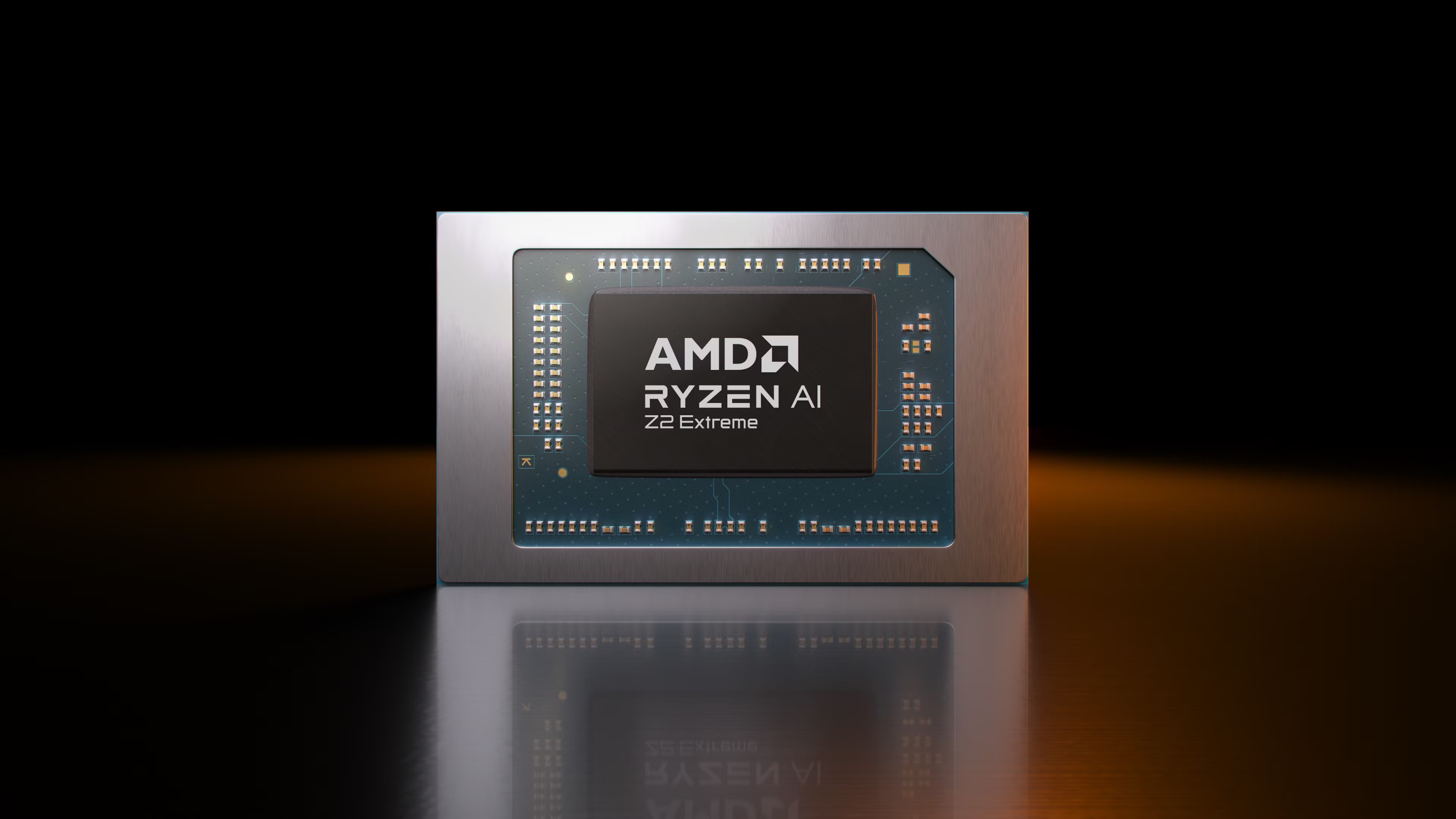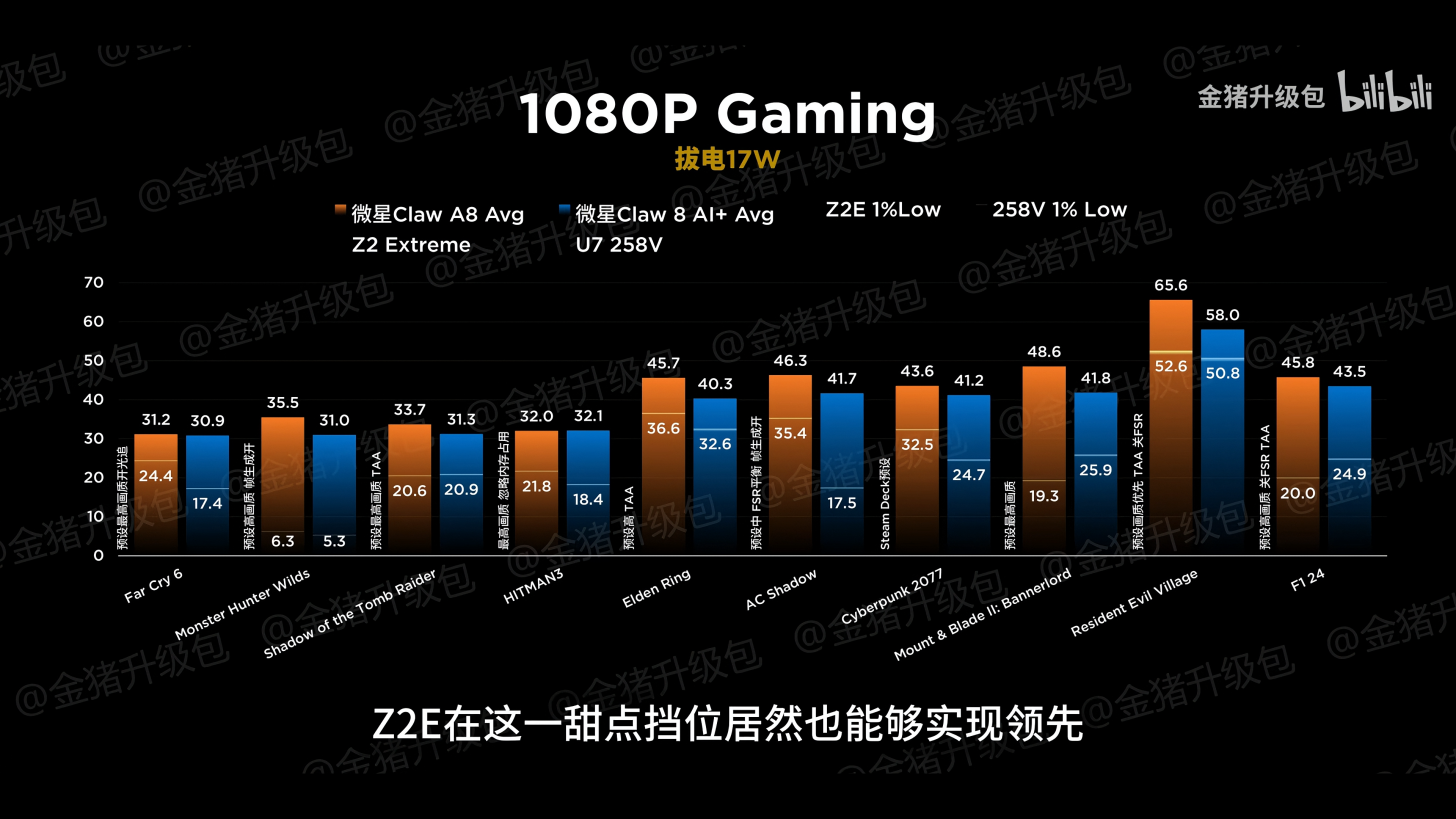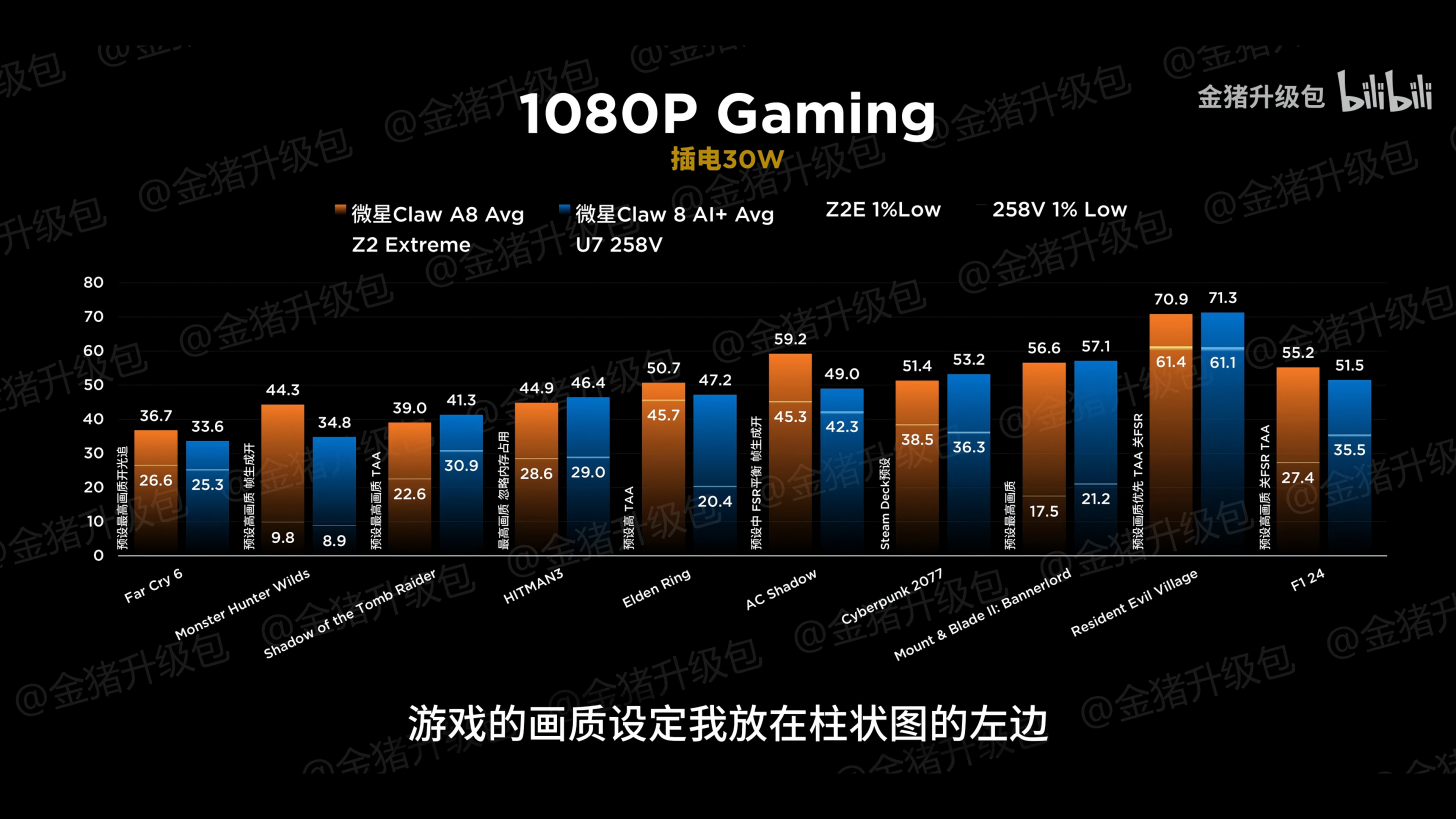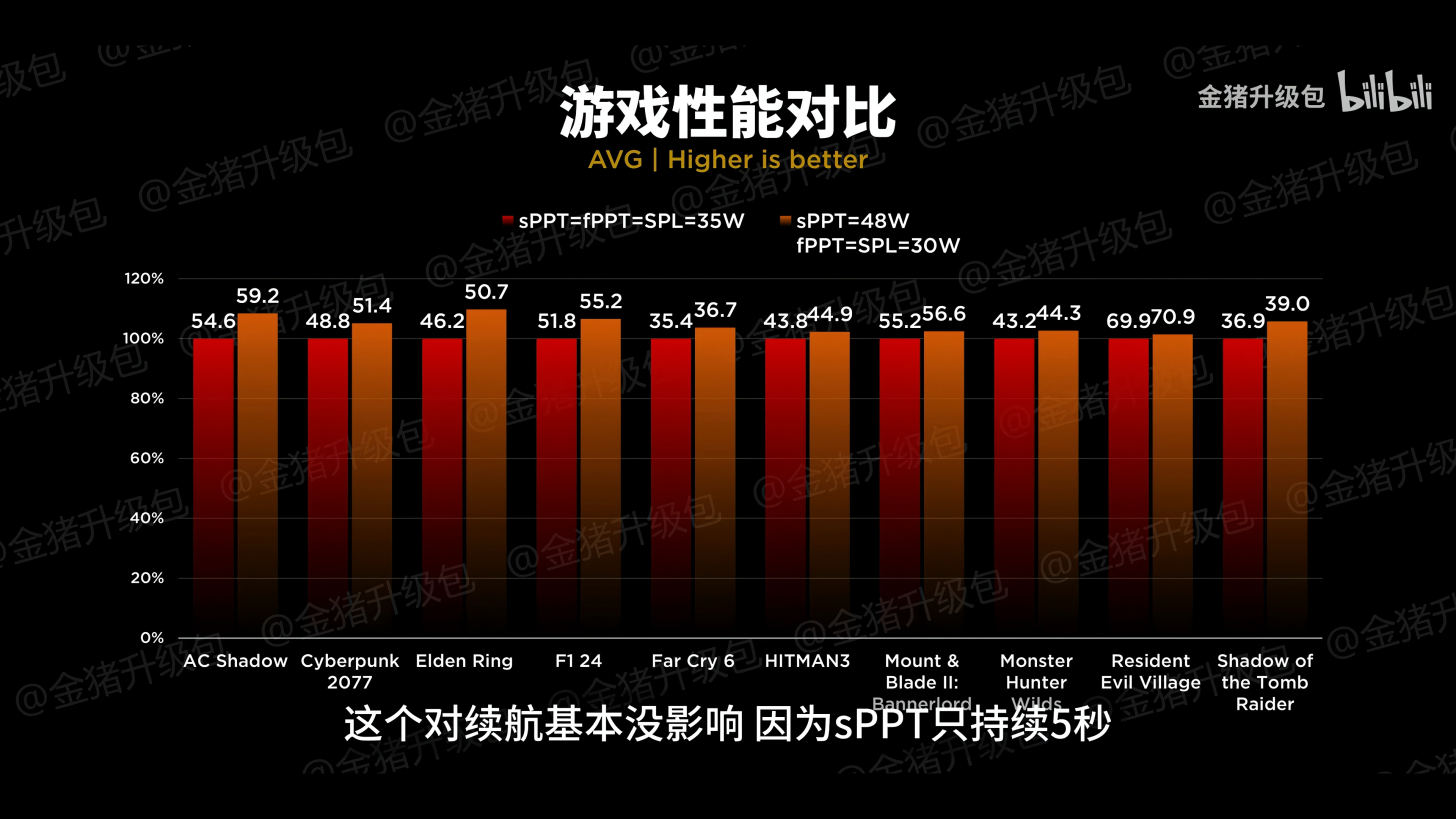AMD's Z2 Extreme flies past Intel's Lunar Lake in new gaming benchmarks — MSI Claw 8 running at 17W favors the Z2E by roughly 8.5%, lead drops to 6% at 30W

We’ve seen plenty of power-versus-performance battles in the handheld gaming space, and the newest one pits two classic rivals against each other. Spotted first by HXL, MSI Claw A8, powered by AMD’s new Ryzen Z2 Extreme, went head-to-head with the Claw 8 AI+ running Intel’s Core Ultra 7 258V. Both chips were tested at different power limits, including the all-important 17-watt range that defines efficiency for handhelds. The Z2 Extreme didn’t just compete—it pulled ahead.
AMD Ryzen Z2 Extreme@17W (MSI Claw A8)vsIntel Core Ultra 7 258V@17W (MSI Claw 8 AI+)https://t.co/dN3oqGzzCX pic.twitter.com/JNmPJHCkjsAugust 3, 2025
Handheld PCs live and die by efficiency, and since both here cost roughly the same—between $900 and $1,000—this comes down to performance-per-watt. At 17 watts, you’re in that delicate balance where the SoC needs to deliver smooth gameplay without torching the battery. Historically, Intel dominated this zone, while AMD’s previous APUs, like the Ryzen 7 8845HS, struggled badly when the power budget dropped below 20 watts. Those parts were designed for laptops, not handhelds (like the Z1 Extreme), and it showed, but according to the review, there's a new sheriff in town now.
The Ryzen Z2 Extreme is AMD’s top-tier handheld SoC, an eight-core, sixteen-thread design based on Zen 5, with three performance cores and five efficiency cores running up to 5.0 GHz. It pairs that with sixteen RDNA 3.5 compute units—effectively a Radeon 890M-class GPU—on TSMC’s 4nm process, and supports LPDDR5X-8000 memory. The power envelope ranges from 15W to 35W. However, this chip relies upon external memory mounted on the device's PCB, so the device should track the power consumption of the onboard memory separately.
Intel’s Core Ultra 7 258V, built on TSMC’s N3B node, also features a hybrid core layout and uses Xe2 graphics (Arc-based), but the design targets slightly lower TDP ceilings and has fewer customization options for OEMs. This chip has memory fused to the chip package, so the power consumption metrics for this chip tend to include the memory power consumption, as well.
It is unclear if the reviewer accounted for the fact that Lunar Lake's 17W power envelope encompasses its onboard memory while the Ryzen Z2 Extreme does not, meaning the latter could be pulling more power overall.



The testing started with a power-efficiency curve to see how performance scales with wattage. At just 10 watts, the Z2 Extreme was already hitting over 20 FPS in the GR Extreme benchmark—an 80 percent uplift over last year’s Z1 Extreme, which barely managed 11.5 FPS under the same condition. That alone set the tone, but there was a quirk. Under the default power configuration—where FPPT, SPPT, and SPL were all equal—the performance curve behaved strangely after 30 watts. Frame rates began to regress instead of improving.
For context, FPPT stands for Fast Package Power Tracking, SPPT is Slow Package Power Tracking, and SPL is the sustained power limit. These define how much power the SoC can pull for short boosts and for steady workloads. If they’re all set to the same value, the CPU can grab more power than it needs, starving the GPU. That’s exactly what happened here, so the fix was simple: lock SPPT to 48 watts. This short boost only lasts five seconds, so it doesn’t really affect battery life. Once adjusted, the curve normalized—but the real surprise came at 17 watts.
Get Tom's Hardware's best news and in-depth reviews, straight to your inbox.
The showdown moved to real-world games at 1080p with both chips capped at 17 watts and it's safe to say the numbers were telling:
Game (1080p, 17W Limit) | AMD Ryzen Z2 Extreme (FPS) | Intel Core Ultra 7 258V (FPS) |
|---|---|---|
Monster Hunter Wilds | 31.8 | 25.7 |
Cyberpunk 2077 | 43.6 | 41.7 |
Resident Evil Village | 65.6 | 58.0 |
Far Cry 6 | 31.2 | 30.9 |
Average Lead | +8.5% in favor of AMD |
It’s not just the averages that matter here either, AMD had stronger 1% lows, meaning the gameplay felt smoother overall. The reviewer admitted it outright: “I have to apologize. I was too loud before—I didn’t understand mobile SoCs, and I didn’t understand AMD.”
Moving on, at higher power targets of around 30 watts, the gap closed but didn’t disappear. AMD still held about a 6% advantage on average, with Intel picking up wins in a few games. This back-and-forth was expected because Z2 Extreme’s scaling flattens out after 20 watts; once you hit that point, throwing more power at it doesn’t translate into big gains. Intel, meanwhile, gets more benefit from the extra headroom than AMD does, though not enough to take the crown.
Specification | AMD Ryzen Z2 Extreme | Intel Core Ultra 7 258V |
|---|---|---|
Architecture | 3x Zen 5 P-cores + 5x Zen 5c E-cores | 4x Lion Cove P-cores + 4x Skymont E-cores |
GPU | 16 RDNA 3.5 Compute Units | 8 Xe2 cores (Arc 140V) |
Process Node | TSMC 4nm | TSMC N3B |
Memory Support | LPDDR5X-8000 | LPDDR5X-8533 (MSI Claw 8 AI+) |
TDP Range | 15W – 35W | 7W – 30W |
This is an important development, and it matters so much because it reverses what we've seen from the Red Team for years. AMD’s architectural changes—hybrid cores, RDNA 3.5 graphics, and that 4nm process—make the Z2 Extreme a monster under 20 watts. Intel still fights back at ultra-low power levels like 10 watts, so in strict battery-saver mode, Lunar Lake could still have an edge. For the majority of users playing at 15 to 20 watts, though, AMD finally appears to have the upper hand — at least it does if the power measurements for Lunar Lake aren't also inclusive of its onboard memory, which would give the Z2 Extreme an unfair advantage.
There’s also a useful optimization for those who want extra efficiency: locking all threads to the smaller efficiency cores can improve performance by around ten percent at lower power levels, as shown in the tests. This means AMD now performs better in the range that matters most, while Intel’s Lunar Lake still holds an advantage in very low-power or idle scenarios.
If you’re deciding between the MSI Claw A8 and the Claw 8 AI+, both priced similarly, the Z2 Extreme version offers stronger GPU performance and more consistent frame pacing. With a higher TDP ceiling of 35W, it also gives you extra headroom when plugged in.

Hassam Nasir is a die-hard hardware enthusiast with years of experience as a tech editor and writer, focusing on detailed CPU comparisons and general hardware news. When he’s not working, you’ll find him bending tubes for his ever-evolving custom water-loop gaming rig or benchmarking the latest CPUs and GPUs just for fun.
-
excalibur1814 When I was young, we used to play Doom, Hexen and UT using great big monitors. On occasion, we'd forget to set the refresh to 60Hz. Man, when we stood up we'd feel sick. "Opps, must set the screen to 60!"Reply
For me, that's the minimum benchmark. 60fpx, minimum. Anything else is a bonus. Just look at those benchmarks. If it cannot hit 60fps (ideally never dip below 60) , then is it really worth it? -
abufrejoval For me the most important change is that AMD now feels comfortable to offer ever more bespoke APU designs.Reply
Their first generations of Zen were all about getting the most out a small number of "Lego bricks" and even the initial APUs were still only a single die, that was used across a maximum range and not great at covering the entire field, leaving quite a few spots open for Intel.
Now they seem ready to do onto Intel what Intel did onto them, starving them of oxygen and opportunities to live and grow, by adding chips, that are still made from a minimum of logical IP blocks, arranged in various ways, but expensive to physically make, unless they have the scale of a market leader... which they either already have become, or have every intention to be.
And as to Lunar Lake, it's just brutal how AMD can crush them there economically, by delivering more compute at similar power using far more conventional technology. -
usertests This was a surprise to me because I remember seeing Lunar Lake winning against Strix Point in some comparisons. I guess ditching the 12 cores while retaining 16 CUs really helps.Reply
They're even doing it with slower memory than the Lunar Lake chip.
What settings are the benchmarks using? It's often ultra, when medium/high could be used to get more FPS.excalibur1814 said:For me, that's the minimum benchmark. 60fpx, minimum. Anything else is a bonus. Just look at those benchmarks. If it cannot hit 60fps (ideally never dip below 60) , then is it really worth it?
There's also upscaling, but it's unfortunate that RDNA3.5 APUs have not gotten FSR4. -
watzupken Reply
I believe this is indeed the case. Lunar Lake itself is just an 8 cores design and so probably gave it an advantage when it comes to power consumption. Anyway, coming from a Ryzen Z1 Extreme user, the Z2 Extreme is not attractive at all. Just as you rightfully called out, the decision to stick to RDNA 3.x means that you are stuck with older hardware and missing key features. The performance uplift isn't great either.usertests said:This was a surprise to me because I remember seeing Lunar Lake winning against Strix Point in some comparisons. I guess ditching the 12 cores while retaining 16 CUs really helps.
They're even doing it with slower memory than the Lunar Lake chip.
What settings are the benchmarks using? It's often ultra, when medium/high could be used to get more FPS.
There's also upscaling, but it's unfortunate that RDNA3.5 APUs have not gotten FSR4. -
DS426 Reply
Benchmarks don't target a frame rate -- you simply have a resolution and overall graphics quality setting or group of key settings like AA, Aniso, etc. and let'r rip. For actual playability, yes, each user will need to adjust settings to get to the FPS level that he or she is comfortable with.excalibur1814 said:When I was young, we used to play Doom, Hexen and UT using great big monitors. On occasion, we'd forget to set the refresh to 60Hz. Man, when we stood up we'd feel sick. "Opps, must set the screen to 60!"
For me, that's the minimum benchmark. 60fpx, minimum. Anything else is a bonus. Just look at those benchmarks. If it cannot hit 60fps (ideally never dip below 60) , then is it really worth it?
That said, sure, we can draw the conclusion that even today's best APU's on handhelds still aren't strong enough to max out native 1080P at 60+ fps without frame generation. -
DS426 Reply
It's rare IMO that any gen-on-gen advances with CPU's and GPU's are significant or exciting in recent times. I mean, could you realistically expect otherwise for the Z2E?watzupken said:Anyway, coming from a Ryzen Z1 Extreme user, the Z2 Extreme is not attractive at all. Just as you rightfully called out, the decision to stick to RDNA 3.x means that you are stuck with older hardware and missing key features. The performance uplift isn't great either.
RDNA 4 is admittedly one exception, one which indeed is a curious thing to wonder how it would perform scaled down in something like a Z2E compared to RDNA 3.x -
DS426 ReplyIt is unclear if the reviewer accounted for the fact that Lunar Lake's 17W power envelope encompasses its onboard memory while the Ryzen Z2 Extreme does not, meaning the latter could be pulling more power overall.
Yeah, we're going to need confirmation regarding that as to me, it appears that LL's on-package mem's power draw isn't being accounted for. As @usertests mentioned, early benchmarks showed LL ahead of Strix Point in laptops, sometimes by a fair margin. Granted, yes, we're talking about higher power envelopes there and yes, AMD probably has a small efficiency advantage and therefore closes the gap in handhelds. -
Notton In early Claw A8 benchmarks, Z2X was losing against LNL and Z1X, so it's good to see firmware and driver updates bring the Z2X in line with what is expected.Reply
The key selling features of 2nd gen handhelds has been the improved ergonomics and room for a 2280 instead of a 2230/2242. -
ihateregister Pretty sad when you cherry pick benchmarks to saying "overall faster" in specific games. Then later admit that intels chip has higher fps in some games. If I only play starfield, why would I care about league of legends FPS? Why occlude info on what games AMD is behind on? Seems misleading to me.Reply
Let's also add that Core Ultra 7 was release sometime in January at the start of the year. I hope that intel releases a competitive alternative to the Z2 extreme that you can't even buy yet. I have a steam deck. I think I'll wait a bit more before upgrading.